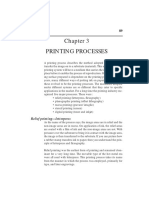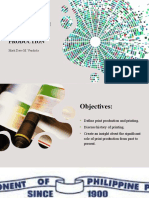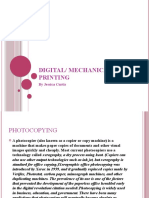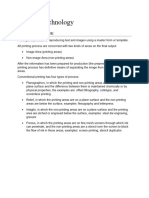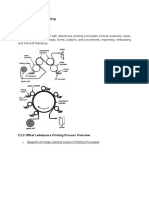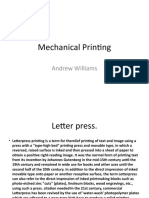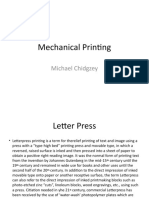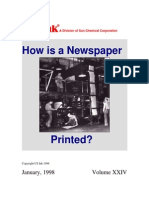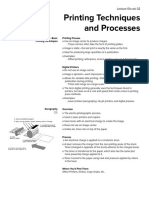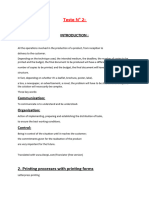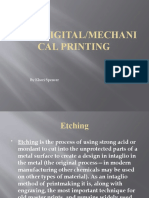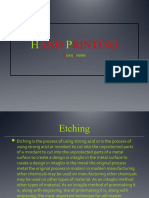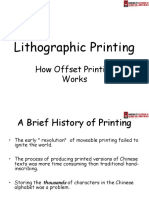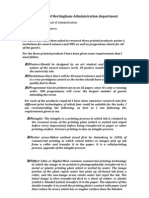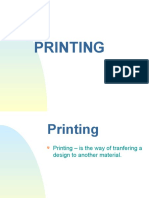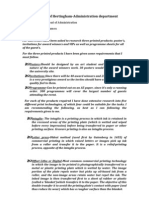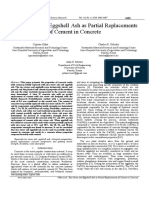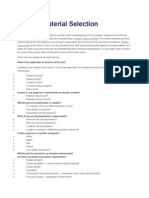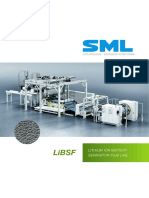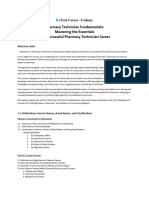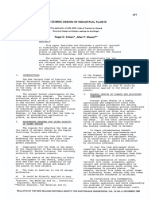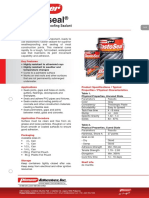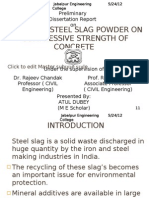TAMALE TECHNICAL UNIVERSITY
DEPARTMENT OF GRAPHIC COMMUNICATION
DESIGN TECHNOLOGY
LECTURE NOTES
ON
GRAPHIC DESIGN
PRODUCTION I
(2nd Year HND Graphics, First Semester)
COURSE CODE: IAG 255
COURSE TITLE: Graphic Design Production I
CREDIT HOURS: 3
COMPILED BY
Alhaji Dr. M. B. Agbankudugu
07/02/23
1|Page
� FUNDAMENTALS OF PRINTING PROCESSES
Printing is a means of transferring ink impressions from a press plate to paper, metal or any
other material. In other words substrate.
The three Major Printing Processes
The three Major Printing Processes are
1. Relief
2. Intaglio
3. Planography
RELIEF PRINTING
This method of printing is probably the oldest process (screen printer might dispute this) and
has been used for thousands of years. A raised image is created, ink is placed in that image
and it is then transferred, usually by applying pressure, onto a substrate (paper, cloth,
cardboard, plastic etc). This is why it is sometimes called letterpress printing.
Letterpress
Letterpress is the commercial form of relief printing. “Letterpress is one of the oldest and
most beautiful printing techniques and dates back to the invention of the movable type by
Johann Gutenberg. It began as an alternative to laborious hand-written calligraphy. Metal
plates with the images raised are inked and then pressed against soft cotton paper. Type was
hand-cast and individual characters were hand-set into lines until machine set composition
made the process easier. This technique is almost a form of art rather than science as no two
pieces are exactly alike. Because the paper is run through an antique press dating back to the
1800s, each piece is subtly unique. Today, not only do letters appear crisp on the heavy
cotton paper, but you can feel the recessed texture around the type. This is a distinctive
2|Page
�characteristic of letterpressing. From the look and feel of each piece, it stands out among
other printing types found today.”
Letterpress printing had almost become a thing of the past but is now enjoying a renaissance
as people look beyond the mass produced in favour of the handmade. The boutique wedding
invitation is responsible for a lot of this resurgence, but designers are turning and returning to
the unique qualities that can only be found in a hand printed piece. The term 'letterpress'
comes from the simple process that brings ink and paper together. In Letterpress Printing, the
letters and designs to be reproduced are raised above the non-printing areas of the press plate.
In printing, ink is applied only to the raised areas (type/design) by means of ink rollers.
Three main forms of Letterpress Presses
1. Platen Press
2. Flat-Bed Cylinder Press
3. Rotary Press
PLATEN PRESS
A printing press in which the impression is made when a flat surface called a platen pushes
the substrate against the type. Types of Platen Press include:
1. Light Platen Press (Clamshell)
2. Medium Platen Press
3. Heavy Platen Press (Parallel Approach)
Light Platen Press
Light Platen Press is also known as clamshell, meaning the press makes impression when
both the bed and the platen come together. In this case, the paper rests on a flat surface
known as the platen, and is forced against the printing image carrier, which is positioned on
another flat surface known as the bed.
3|Page
�Light Platen Press
Advantage of Light Platen Press
• Good for printing of cards
Disadvantage of Light Platen Press
• There is uneven distribution of ink on the printed surface, thus making the print
blurred.
Medium Platen Press
In Medium Platen Press, the bed is fixed in a vertical position. This means that, the platen
does the movement to make impression.
4|Page
�Advantages of Medium Platen Press
• Inking system is better than the Light Platen Press
• Even spread of ink of printing surface
• Prints bigger formats such as books
• Bigger and stronger than Light Platen Press
Heavy/Parallel Platen Press
In Heavy/Parallel Platen Press, the platen first lies diagonally and prints by moving into a
vertical position before paralleling to make impression.
5|Page
�Advantages of Heavy/Parallel Platen Press
• Prints bigger formats such as books apart from cards
• Can perform Die-Cutting.
FLAT-BED CYLINDER PRESS
The Flat-Bed Cylinder Press is basically made up of a flatbed which carries the image carrier
(forme) and a cylinder which imparts the necessary pressure for impression to be made. In
operation, the movements of the impression cylinder and the bed are synchronized such that
whiles the bed gets the forme inked; the cylinder picks the paper to be printed. Then the
impression is made when the bed moves horizontally towards the cylinder while the latter
also descends with the paper and rolls over the inked forme. At this same time, the bed also
continues its movement until the image is transferred onto the substrate/paper. After this, the
cycle begins again.
6|Page
�Advantages of Flat-Bed Cylinder Press
The press is faster than the platen presses and prints bigger formats. It is therefore ideal for
posters and multi-sectional book work.
ROTARY PRESS
The Rotary Press operates on the principle of printing on every revolution of the impression
cylinder. Basically, it consists of an impression cylinder and a plate cylinder. Rotary Press is
designed to be either sheet-fed or web-fed.
7|Page
�Advantages of Rotary Press
• It runs at a high speed.
• It can take three (3) plates at the same time.
• It is designed to be a perfecter press, meaning it can print both front and back.
• It can prints larger format
• It also prints in a continuous web of paper or roll paper.
Disadvantages of Rotary Press
• It cannot do die-cutting
INTAGLIO PRINTING
Intaglio printing is the opposite of relief printing, in that the printing is done from ink that is
below the surface of the plate. The design is cut, scratched, or etched into the printing surface
or plate, which can be copper, zinc, aluminum, magnesium, plastics, or even coated paper.
The printing ink is rubbed into the incisions or grooves, and the surface is wiped clean.
Unlike surface printing, intaglio printing which is actually a process of embossing the paper
into the incised lines requires considerable pressure. Intaglio processes are probably the most
versatile of the printmaking methods, as various techniques can produce a wide range of
effects. The commercial form of Intaglio is Gravure. This is also a direct form of printing.
Since the image is represented by wells or cells, the printing surface is first flooded with ink.
Then a flexible steel blade (Doctor or Doctor Blade) wipes the non-image areas clean of
excess ink, leaving ink in only the sunken wells or cells. The image is subsequently
transferred directly to the paper.
8|Page
�GRAVURE PRINTING PRESS
Gravure printing is made up of Photo- Gravure and Roto-Gravure. Gravure presses are
designed to print high quality impressions at extremely high speeds. Gravure image carriers
are made photomechanically. Photo- Gravure prints from etched plates while Roto-Gravure
prints from etched cylinders. Photo- Gravure is usually sheet-fed while Roto-Gravure is web-
fed.
Photo-Gravure
9|Page
� Roto-Gravure
The plate cylinder gets inked by rotating in a trough of ink. The surface is then wiped off
with a tin flexible steel blade called Doctor, which runs with an oscillating movement over
the full width of the cylinder, removing the ink from the surface and leaving it in the etched
cells. The impression cylinder which has a coating of vulcanized rubber, forces the paper
against the plate cylinder to make the impression.
Photo-Gravure can produce up to 3,500 impressions an hour, while Roto-Gravure is capable
of printing from 4,000 to 10,000 copies an hour. This process is used mainly for printing
continuous jobs such as wallpaper, newspaper and catalogues among other high quality jobs.
PLANOGRAPHY
This mode of printing is sometimes referred to as indirect or chemical printing. It is a printing
process in which the image areas and the non-image areas of the printing plate are on the
same plane. Planography in all its forms is based on the principle that grease or oil repels
water and will attract or hold another grease or oil. A principal example of planographic
printing is Lithography, the commercial form of which is Offset Lithography. It is often
referred to as Offset or Lithography
10 | P a g e
�In lithography (as opposed to relief printing in which the image area is raised and intaglio, in
which the image area is incised), the printing and non-printing areas are on the same plane on
the surface of a thin metal plate and the definition between them is maintained chemically.
The printing parts of the surface repel water when moistened, but absorbed the ink with
which they are coated, whereas the non-printing parts absorbed the water and repel ink.
OFFSET LITHOGRAPHIC PRESS
Offset Lithographic presses are of the rotary type which employ a rubber blanket wrapped
round a third cylinder in transferring images onto the substrate. It is the most modern method
of printing among the 3 major printing processes.
To print, the plate cylinder is first made wet by the dampening rollers before it comes into
contact with the ink rollers. The fountain solution prepares the hydrophilic areas on the plate
to reject the oil based ink while the oleophilic areas (representing the image areas) will reject
the fountain solution and accept the ink. The inked plate then comes into contact with the
blanket cylinder where the image is offset onto it. The offset image subsequently comes into
contact with the substrate with the aid of the impression cylinder. The image is then
transferred the right way up. This process is either sheet-fed or web-fed. The latter is thus
referred to Web Offset Press. It prints a variety of jobs including high quality bookwork,
newspapers, posters and catalogues. It can also prints on wide variety of substrates including
metals, card, etc.
11 | P a g e
� One-Colour Offset Lithographic Press
12 | P a g e
� Two-Colour Offset Lithographic Press
13 | P a g e
� Four-Colour Offset Lithographic Press
14 | P a g e
�Direct Lithography
Alois Senefelder, after much experimenting, invented lithography in 1798/99. He achieved this
feat by drawing in reverse with a greasy crayon/pastel on slaps of highly polished, close-textured
limestones. This particular type of Calcium Carbonate was available near his hometown called
Solenhofen in Bavaria (Munich). The surface of the stone is then wet with a fountain solution
(water, gum arabic and acid). The background (non-image areas) accepted the solution due to a
porous nature of the stone, but the image areas drawn with the greasy pastel rejected it. When the
oil-based printing ink was applied subsequently, the background rejected it while the image areas
accepted it. A sheet of paper was then place over the inked stone, a blanket laid over the paper,
and then the necessary pressure applied to take a print.
Indirect Lithography
This is commercially referred to as offset Lithography, Offset or Lithography. The indirect
property of this process is reflected in the fact the image is first offset onto a rubber blanket,
which then transfers it onto the paper with the aid of the impression cylinder.
Lithography is distinguished from other printing process because of the particular arrangement of
the image and non-image areas of the printing plate. It is worth recalling here that the
establishment of an ink-receptive, water-repelling image on the surface of the lithographic stone
and the treatment of the non-image areas with chemical solutions to produce a water-retaining,
ink-resisting surface, was the foundation of Senefelder’s invention. The porous stone has been
replaced with thin flexible metal printing plates formulated to fit round the plate cylinder.
The Lithographic Plate
The lithographic plate functions on a planographic basis. That is the image areas are oleophilic
(grease-loving) and the non-image areas are hydrophilic (water-loving). Both areas are on the
same plane and are of equal importance in the correct working of the process.
The original base onto which these image and non-image areas rested was the limestone slabs of
Bavaria (hence the name lithography from the Greek words for stone: Lithos and writing:
Graphe). Senefelder was aware that the base material for the process could be any substance so
15 | P a g e
�long as it was prepared correctly to support the oleophilic surfaces. This is demonstrated clearly
in the considerable variety of lithographic plates, which have paper, plastic, stainless steel,
aluminum, zinc and brass as based materials.
Surface Characteristics:
The surface characteristics of the lithographic plate can be divided into two classes. The surface
plate, in which the image is formed on the plate’s surface, and sub-surface plate, in which the
image is formed slightly recessed (about 0.008mm) below the hydrophilic surface.
OFFSET PLATE-MAKING
After the “flat” has been prepared using the mechanical, a photographic paper proof is made
using the “flat”. This proof shows the client the exact positions of the elements.
While preparing the photographic paper proof or blue print, the plate-maker could also apply a
light-sensitive coating to the surface of the base material to be used. This is usually done by
fixing the plate in a Whirler which ensures the even application of the coating. With pre-
sensitized plate, a special chemical is applied to the metal by the plate manufacturer. Pre-
sensitized plate can be negative-working, positive-working, or both and this flexibility is
advantageous by way of convenience as well as in times of economic problems.
All photomechanical methods of producing lithographic plates rely on the principle of light
affecting the coated surface. The type of light sensitive-coating on the plate dictates the solvent
in which it will be soluble. However, the light-sensitive coating may either be rendered insoluble
on exposure or decomposed or solubilized by light, the former intended for use with negative and
the latter with positives. The plate is either developed manually or put through an automatic
processor. After this, the developed plate’s surface is protected by applying a solution of Gum
Arabic to the surface. In so doing, the problem of scumming is prevented. The processed plate
may now be classified as either “negative-working” or “positive-working”, depending on
whether exposure was made through negative or positive.
16 | P a g e
�OFFSET LITHOGRAPHIC PRINTING FAULTS
The main factors responsible for offset lithographic printing faults include paper, press, printing
plate, ink and the human factor. One cannot discuss all these faults but the common ones include:
Chalking/Powdering
This occurs when the ink is expired and the vehicle separates itself from the other components in
the ink.
Solution
It is solved by using a fixative. The ink trough is emptied and filled with varnish to print over the
printed piece.
Crystallization
Is when the first colour is dried too much to be able to accept another colour.
Solution
The printed piece is discarded and re-print
NB: Ink for two or more colours press dries faster than ink for one colour press.
Emulsification
Emulsification occurs when the fountain solution find its way into the ink as a result of the ink
losing its strength or elasticity.
Solution
The ink is changed. This is done by cleaning the ink trough, the rollers and the plates (press).
Tinting
Tinting occurs when particles of ink pigment bleed into the fountain solution, and are transferred
onto the non-image areas of the plate, printing as a coloured tint.
17 | P a g e
�Solution
The fountain solution is changed
Hickey
A hickey is a small spot or imperfection that appears in print on images or flat tints. It is
sometimes called a bulls eye or fish eye. The problem is most visible in areas of heavy ink
coverage. There are two types of hickeys:
Void Hickeys are blank, unprinted spots in a printed area.
Doughnut Hickeys are solid printed areas surrounded by a circular unprinted area. Doughnut
hickeys produced by particles of ink skin collecting on the blanket or plate are called ink hickeys.
Hickeys are caused by dirt, paper fibers or hardened specks of ink on the printing plate or
blanket. On offset presses the addition of a special roller, called a hickey-picking roller, can
minimize the effects of hickeys.
Moiré
In the world of offset print and graphics, moiré patterns arise when a preprinted image is
scanned, interference occurs between the ruling of the dot pattern of the original print and the
scanner’s sample pattern. Filters can be used during the scan process to “descreen” the result and
minimize the moiré; however it is always best in printing to avoid scans of pre-printed pieces for
your artwork. Even descreening results in a less sharp image, and a ‘softer’ or fuzzier appearance
Solution
1. If the copy will not be enlarged or screen, then you disengage the screen and shoot it.
2. If you want to enlarge or reduce the image, then you photograph at an angle of 300 from
the original angle 300
3. when using a scanner, you discreen and scan
18 | P a g e
�Picking
The term picking also refers to a printing problem occurring in multi-color flexographic printing
in which the plates of successive colors remove bits of the first printed color, commonly caused
by printing on still-wet ink. Flexographic picking can be alleviated by ensuring that the first
down color has the most rapid drying time
Solution
You dilute the ink to reduce its thickness
Scuffing
Refers to a situation where the ink is having too much non-drying oil and therefore creates
problem when printing packages. It is noticed long after printing during transportation.
Solution
You have to discard the prints.
Scumming
In offset lithography, scumming is a generic term for the presence of ink on non-image areas of
the printing plate, which can be caused by a variety of press conditions, in particular the use of a
fountain solution that is too acidic, where the solution begins to eat away at the surface of the
metal plate and its protective coating, or by a fountain solution that is too alkaline, as the
desensitizing properties of gum arabic are lost at a pH greater than 5.0.
In other words, is when hydrophilic become oleophilic, then we are experiencing scumming.
Solution
You change the fountain solution.
Set-off
The term in offset printing also refers to the unwanted transfer of ink to rollers and friction points
throughout the printing press. Ink that is not properly dried or set can build up over time and
19 | P a g e
�cause marking on the finished product or when we have the printed image appearing at the back
of the print.
Solution
When it is identified early, you stop the process and change the ink.
Show-through
This refers to a situation where printing is done on a lower grammage of paper
Solution
You change the paper/stock (paper/substrate)
Strike-through
This refers to where the vehicle in the ink seeps into the fibre and creates a loop around the
printed piece.
Solution
You change the ink
Poor Trapping
Occurs when the first ink on the printed piece dries beyond the point to be able to attract the
subsequent ink properly. Though it can attract some of the ink but not all.
Solution
You discard the printed piece
20 | P a g e
�SUBSIDIARY REPROGRAPHIC PROCESSES
Flexography
In Flexography, the content that needs to be printed is on a relief of a printing plate, which is
made from rubber. This plate is inked and that inked image is subsequently transferred to the
printing surface. The process can be used to print on paper as well as plastics, metals, cellophane
and other materials. Flexo is mainly used for packaging and labels and to a lesser extent also for
newspapers.
Thermography
Thermography refers to a printing process that uses heat to create images on a sheet of paper.
Thermography or thermographic printing is a printing process that causes text or graphics to be
slightly raised from the substrate. The resulting visual effect is interesting, making this a
technique that is commonly used on wedding invitations, letterheads, business cards, greetings
cards, gift wrap, diplomas and packaging. Since it is also a tactile effect thermography can be
used to print braille text.
Letterset
This process combines some qualities of letterpress and the convenience of offset. Letterset is
also known as Dry Offset. It is mainly used in the packaging industry
Collotype
In Greek, Cola means glue. Therefore, Collotype refers to glue printing. Another name for
collotype is PHOTOGELATIN. Collotype is also called Photocollography. A photomechanical
printing process that gives accurate reproduction because no halftone screen is employed to
break the images into dots. In the process, a plate (aluminum, glass, cellophane, etc.) is coated
with a light-sensitive gelatin solution and exposed to light through a photographic negative. The
gelatin is hardened in exposed areas and is then soaked in glycerin, which is absorbed most in the
non-hardened areas. When exposed to high humidity, these areas absorb moisture and repel the
greasy ink. The hardened areas accept the ink, and the plate can be used to print a few thousand
copies of the positive image.
21 | P a g e
�Serigraphy (Silk Screen Printing)
Serigraphy, also known as silk screening, screen printing or serigraph printing, is a stencil-based
printing process in which ink is forced through a fine screen onto the paper beneath. Screens
were originally made of silk, but they are now made of finely woven polyester or nylon. The
screen is stretched over a wood or aluminum frame, then areas of the screen are blocked off with
a stencil (a negative of the image). The screen is then placed on top of paper, and ink is placed on
the screen. A rubber-bladed squeegee is used to spread the ink evenly across the screen, allowing
ink to pass through the open spaces onto the paper below. A different screen is used for each
colour in the print, resulting in a final serigraph with great colour density, colour saturation and
texture.
Duplicating
This was used before photocopy (for office works). Another name for duplicating machine is
called CYCLOSTYLING MACHINE
Electrostatic Printing (Xerography)
Xerography, also known as electrophotography, is a printing and photocopying technique that
works on the basis of electrostatic charges. The xerography process is the dominant method of
reproducing images and printing computer data and is used in photocopiers, laser printers and
fax machines. The term derives from the Greek words xeros, meaning dry and graphos , meaning
writing.
Ink-Jet Printing
This process works in conjunction with the computer. The printer employs water base ink.
Because it prints in dots, the scales/celebrated edges are not straight (rough). The ink used is
water proof (for billboard) because it is for outdoor display (substrate is synthetic). Inkjet
printing is therefore a type of computer printing that recreates a digital image by propelling
droplets of ink onto paper, plastic, or other substrates. Inkjet printers are the most commonly
used type of printer, and range from small inexpensive consumer models to expensive
professional machines such as the large digital ink-jet printers.
22 | P a g e
�Laser Printing
Laser printing is an electrostatic digital printing process. It works in conjunction with the
computer. The underlined principle is the same as the electrostatic printing. It produces high-
quality text and graphics by repeatedly passing a laser beam back and forth over a negatively
charged cylinder called a "drum" to define a differentially charged image. The drum then
selectively collects electrically charged powdered ink (toner), and transfers the image onto paper,
which is then heated in order to permanently fuse the text and/or images.
Photography
Photography is the process of producing a final image on paper for viewing, using chemically
sensitized paper. The paper is exposed to a photographic negative, a positive transparency (or
slide), or a digital image file projected using an enlarger or digital exposure unit such as a Light-
Jet printer. Alternatively, the negative or transparency may be placed atop the paper and directly
exposed, creating a contact print. Photographs are more commonly printed on plain paper.
In photography,
• It is not advisable for long run job.
• It is slow
• It costs
• Conventional process will slash down to 1/10 of the cost
23 | P a g e

